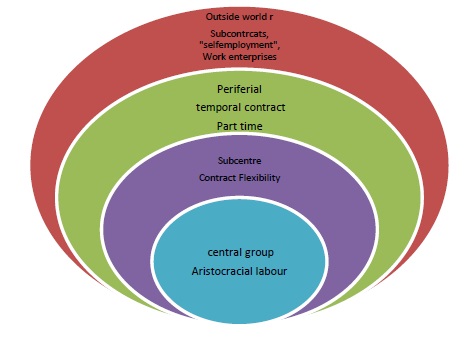
Figure N ° 1: Flexible organization model
Source: Own elaboration Adapted from Martínez, 2014
Dignified and Decent Work: A View from The ILO For The Generation of Indicators For SMES Mexican and Colombian
(*) Montoya Agudelo, César Alveiro; (**) Méndez Cruz, José Ricardo; (***) Boyero Saavedra, Martín Ramiro
(*) Facultad de Ciencias Económicas, Administrativas y Afines
Universidad Cooperativa de Colombia
Medellín, Antioquia, Colombia
cesar.montoyaag@campusucc.edu.co
(**) Facultad de Contaduría y Administración
Universidad Autónoma de México
México D. F., Ciudad de México
rmendez@fca.unam.mx
(***) Institución Universitaria CEIPA
Institución Universitaria Escolme
Medellín, Antioquia, Colombia
martin.boyerosa@virtual.ceipa.edu.co
Reception Date: 04/30/17 - Approval Date: 06/27/2017
ABSTRACT
This document is a reflection derived Macro ALAFEC –Latin American Association of Colleges and Schools of Accounting and Administration- led project called Adopt sustainability criteria in value chains in Latin America in the dignified or decent work in Colombia and Mexico In the following lines an analytical presentation of the objectives proposed by the ILO in relation to decent or decent work, seeking thereby identifying the level of compression and implementation of such objectives as private organizations such as SMEs it is made. The development of this work has been based on a literature review in order to generate a set of indicators to facilitate the identification of the manner in private organizations such as dignified or decent work is generated. At the end of the document, a proposed indicator which although not definitive, if allowed to have an approach to some elements to facilitate the measurement of the existence of a dignified or decent work, which allow done can be concluded that both in Mexico as in Colombia, there is still a long way to go in relation to the generation of a real worthy or decent work.
KEY WORDS: Quality of Work Life; Decent job; SME
INTRODUCTION
The quality of working life is a fundamental element for organizations and in this case, for Small and Medium Enterprises (SMEs) to achieve their established objectives, that is why, in this work is shown in a general way as a problem, the absence of mechanisms - such as indicators - to assess the way in which the proposal to generate decent work proposed by the ILO is being answered.
In the first part of this work, we present a general overview of the existing problem of the diversity of indicators proposed to evaluate the decent work management process from dimensions such as: fundamental principles and rights at work, employment opportunities for men and women, women, job security and dialogue or social participation.
The second part is made up of the general objective of the work, which seeks to identify the extent to which the institutions have understood the ILO's proposal in generating work in true decent conditions. Similarly, in this section you will find four specific objectives that seek to identify the way in which work is viewed as a principle and right, the way of generating employment in equal conditions by gender, the security that is being provided in employment and the way in which dialogue and social participation of all workers take place.
The passage through different theoretical sources is constituted in the third section of this document. This is a journey through various theoretical positions that have addressed decent work and quality of work as a source of generation of social development. Similarly, the definition that exists in Mexico and Colombia vis-à-vis SMEs is presented globally, as institutions that generate a high percentage of existing jobs.
Finally, an enunciate proposal is made of indicators that, although they do not constitute methods for the solution of the existing problems facing decent work, will allow that difficulties can be identified when evaluating the levels of application of the strategic objectives of the ILO, objectives that can be considered in any type of organization, including SMEs.
DEVELOPMENT
Problematic Reference
For the International Labor Organization (ILO), since the nineties there has been a concern to put at the disposal of the nations some strategic work proposals that allow fighting against poverty and guaranteeing equality between people, through of aspects such as decent work. In spite of the above, each nation is free to generate its own labor policies, which are expected to be the motor that allows equity and opportunities for all in equal conditions, keeping in mind that work is a universal right that cannot be be denied under any condition of race, gender, belief among other aspects. To respond to the above, the ILO has proposed four strategic objectives accompanied by some cross-cutting objectives in the so-called hemispheric agenda, which have been designed with the purpose of offering decent work and with the firm conviction of overcoming social and economic inequality existings in each nation. In spite of the above, it is important that evaluation mechanisms be formulated to identify the level of adherence of these objectives in both Mexico and Colombia, mechanisms that must be highly comparable to any nation that wants to apply them and to any type of organization. It is necessary to formulate a series of indicators to assess the level of understanding and responsiveness to the fundamental principles and rights of work, the generation of employment opportunities in gender equality, social protection and dialogue and strengthening of the organizations in front of the negotiation processes. It is important to keep in mind that SMEs are the ones which, among others, are called to commit themselves to the fulfillment of these strategic objectives, since they are the institutions that currently move the economy of Mexico and Colombia, as well as being the institutions that contribute the most. to GDP and to be organizations with greater presence in these states.
Objectives
The development of this work, aims to identify the level of adherence to the strategic objectives proposed by the ILO for the generation of decent work in organizations such as SMEs in Mexico and Colombia. In line with the objective previously proposed, the aim is to analyze the level of compliance with fundamental principles and rights as a strategy proposed by the ILO for the generation of decent employment. Identify the level of generation of job opportunities equalities under the framework of the ILO's strategic guidelines for employment.
Get to know the level of compliance with the policies related to social security and pension system according to the strategic objectives of the ILO.
Identify the characteristics of social dialogue and strengthening of organizations through the intervention of decent work according to the guidelines Strategies of the ILO.
The transformation of work in contemporary society: new questions on the old social question
Flexibility or flexibilization is perhaps one of the most distinctive features of the dynamics that have currently transformed the working conditions that are woven into the SMEs and in the global value chains to which they belong. These processes are consolidated, according to Blanch (2003), with the Toyotist production system that supposed a point of rupture with the Fordist production mode, characterized, among other things, by a relatively stable workers' plant, within a Keynesian economic model designed to guarantee full employment. It is important to clarify, however, that the concept of flexibility is polysemic (Arancibia, 2011, Blanch, 2003). Below are some of its meanings:
• Flexibility of the productive organization: which manifests itself with respect to the emergence of the figure of business networks consisting of the phenomenon in which one or more companies hire or outsource some of their activities in other companies, which are responsible for carrying them out through the management of their own human, material and financial resources
• Flexibility in the work organization: characterized by the tendency to require employees capable of adapting to the working conditions required by the organization
• Flexibility of the productive organization: consisting of the technological capacity of a company to channel, modify or adjust its production process, the volume and type of goods produced
• Labor market flexibility: in which different classes can be found of flexibilization: internal flexibility, by means of which the company has the ability to adjust individual working conditions within the limits allowed by the law, these conditions may include aspects such as salary, work schedules, workday or assignment of functions. It can also include external flexibility, which refers to the adequacy of the workers' plant according to production requirements, through contracting forms that make it easier for companies to dispense with labor that they do not need (Arancibia, 2011).
The results of the application of flexibilization policies in the modalities described above have had various assessments ranging from their defense as inescapable mechanisms to ensure the competitiveness and profitability of SMEs, based on the idea of adopting models of organization of open, agile, decentralized, simplified and particular character, in clear contrast with the traditional models of closed, pyramidal, bureaucratic and slow character; as well as its denunciation as processes that have led to the elimination of many of the workers' social achievements through the application of reengineering policies that have often involved the reduction of the personnel plant and the overload of the personnel that remains, with the consequent loss of valuable human and intellectual capital for organizations, or the establishment of forms of underemployment and informal employment that imply precarious conditions, instability and social uncertainty for a large part of the economically active population (Chanlat, 2002).
On the other hand, external factors have to do with the processes unleashed by the phenomenon known as globalization and the characteristics of an economic system in which "productivity and competitiveness depend fundamentally on the ability to acquire knowledge and process information "(Castells, 2000, p.44), which have In turn, led to profound changes in the working conditions of all the economies affected by such processes.
Globalization is a process of integration and synchronization of global processes, particularly of financial markets, international trade, transnational production and production. technological innovation, which transcends the logic of a simple world-economy, (historical reality that became possible at the dawn of modernity with the opening of commercial circuits on a planetary scale) and that therefore implies an intensification of the degree of relationship of economies , companies and countries; whose interaction networks function as a single field of forces, subject to the immediacy and simultaneity that the fact that an event in the global order affects all the other elements involved in it (Blanch, 2003). The forms of this globalization far from being uniform or reduced to its economic implications, involve a multiplicity of differential and paradoxical features in terms of the political, cultural and social processes implied by the experience of a global world, thus the growing commercial integration and the free circulation of capital , is parallel to the restrictions and barriers to the free movement of people imposed by many developed countries to those of the periphery of economic power, in the same way globalization far from being synonymous with processes of cultural homogenization, has also meant the exacerbation of nationalisms and cultural slogans that convey conflicting interests derived from the logics of the same integration process (Cuesta, 2005).
Globalization in this sense is a process not exempt from ideological guidelines that give the integrating process a logic suitable to certain interests, hence the process of globalization is the scene of various social movements that denounce the effects of inequality, exclusion and exploitation labor that result from the accommodating orientation of the globalizing process, particularly from the favoring of the logics that favor the accumulation of capital, the unidirectional free trade (from the center to the periphery, but not the other way around) or relocation practices of the production that they take advantage of cheap labor from developing countries, fostering social dumping practices that favor the pauperization of working conditions in countries as a way to obtain comparative advantages (Da Silva & Ruesga, 2008).
Labor conditions in this context constitute a continuity and discontinuity game as regards the classic salaried work. The conditions of the world of work of contemporary societies, on account of the aforementioned factors, unfold in a diverse repertoire of situations and aspects that complicate, make invisible and displace the classic social tension between capital and work, making new scenarios and actors emerge in social networks whose working conditions from phenomena of stable and well-paid super-employment to forms of underemployment, sub-wage and organizational sub-treatment, all of them integrated in the same dynamics of the globalized world that articulates the different forms of work, while fragmenting and atomizing the interests of those who are immersed there (Blanch, 2003).
The foregoing explains the problematic horizon in which union representation is found and the forms of collective bargaining with which historically the rights of the working class were claimed, with the consequent impacts on their quality of work life. The working conditions generated by the transformations of the world of work in the last third of the 20th century and by the relative implementation of the neoliberal model with different nuances in several countries of the West, led to a growing loss of power of the unions, which were unable to assume the banners of a heterogeneous and complex mass of work, difficult to identify with the traditional working class of relatively common interests and aspirations, coupled with the political transformations that from governments, limited the pressure margin of such organizations to defend or obtain certain labor prerogatives. Thus, individualized forms of negotiation are attended, in line with the processes of labor flexibilization promoted from different fronts at the global level (Castells, 2000).
Business networks, made possible among other things by the rapid development of Information and Communication Technologies (ICT), constitute a framework that explains many of the aforementioned working conditions. The model of flexible organization of many multinationals described by Lorente-Campos (2003) is constituted by a reduction of the plant of workers associated with the company, which retains in its business center or matrix those highly qualified and competent workers with adaptability capabilities and functional flexibility, which make them creators of value for the organization and therefore, in order to preserve them, they enjoy relatively optimal working conditions in terms of salary, social benefits, job stability and ways of managing human resources that promote creativity, self-realization and relations of organizational horizontality. In return, these business networks subcontract many of their activities to other companies whose working conditions tend to be, as they move away from the center, more provisional and unstable, with more precarious forms of remuneration and with Taylorist-type management models, special in those generic jobs that demand low skilled labor and, therefore, easily dispensable and substitutable. Now, according to the above, the flexible organization model is presented below schematically:

Figure N ° 1: Flexible organization model
Source: Own elaboration Adapted from Martínez, 2014
The different strata presented in the previous illustration show differential labor conditions; the sub-center is made up of personnel with relatively replaceable secondary skills, the periphery is made up of low-skilled personnel who assume their working conditions in conditions of greater uncertainty, with temporary hiring methods and numerical flexibility practices; finally, the outer circle is made up of informal forms of work, subcontracted, self-employment economic activities and various forms of work through temporary employment agencies.
The previous model allows us to understand what Blanch (2003) calls the labor polarization between a super-employed elite and an underemployed mass. The characteristic of this situation lies precisely in the fact that the borders between underemployment and unemployment (which originate in the external margins of the flexible organization model and its articulation in business networks) tend to become diffuse, since there is a relative flow constant labor that oscillates between forms of temporary contracts and periods of unemployment. The working conditions of this type of Kleenex employment, of using and throwing or garbage use show a displacement of the traditional struggles over the dignity of salaried work, whose image was represented in the figure of the worker exploited in the industrial production space, to pass to a scenario in which the guarantees of stable salaried work become desirable in the face of irregular, errant and precarious work characteristic of underemployment: "the situation of chronic unemployment and acute underemployment constitute the breeding ground for the new social vulnerability, the new cancer that corrodes the cohesion, stability, welfare and progress of societies organized around the double axis of the market economy and the social state "(Blanch, 2003, p.139).
The working conditions of many of the sectors that survive on the margin of the salary condition likewise tend to be precarious. The quality of working life of such conditions is marked in large part by a decrease in social coverage, wages, contractual conditions (more similar to a commercial contract) and labor law guarantees, or even, despite the consecrated by law, there are forms of submerged employment or employment that coexist within the framework of legal guarantee systems, for example that which is performed by illegal immigrants (Rinken, 2004). Agulló (2001) synthesizes the dimensions in which such precarious work manifests:
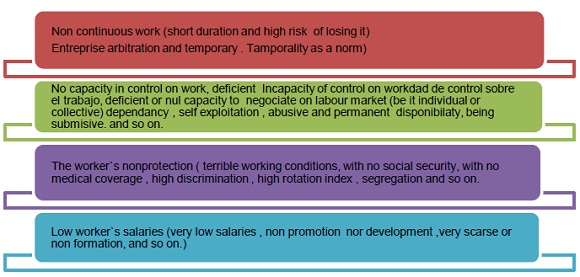
Figure N° 2: Flexible organization model
Source: (Agulló, 2001, p. 106)
The previous dimensions are in no way generalizable to all forms of work in today's society, however they do manifest the reality of a good portion of the parties involved in the application of what Blanch (2003) calls flexi-precarity, alluding to this is due to the policies of flexibilization and re-engineering of organizations, whose enthusiastic application as models that favor competitiveness, productivity and efficiency, has its counterpart in the reading that is made of them as factors of labor instability, social uncertainty and degradation of the salary status and quality of work life.
Working conditions and quality of working life (CVL): a conceptual approach
According to Blanch (2007), the concept of working conditions refers to:
"Set of ecological, social, economic, legal, technological, etc. circumstances, within the framework of which the work activity develops. They influence on work experience and on labor relations, on the daily life of working people and on organizational dynamics, on the quality of life at work, on motivation, job satisfaction and performance and on efficiency and the efficiency of the same organizations. " (p. 20)
The working conditions for Blanch (2003), seventeenth century are far from the current. Before the so-called industrial revolution there was a predominance of work in the field and all activities were developed giving prominence to the farmer, and then pass to the industrial worker. In this same sense, the working days also had transformations, since with the industrial era work hours are extended as well as weeks and shift work is established, which in one way or another has a relationship with the conditions labor In contrast to the above, Peiró and Prieto (1996), cited by Blanch (2003), have proposed a series of classifying elements of working conditions within the organization, as presented in the following table:
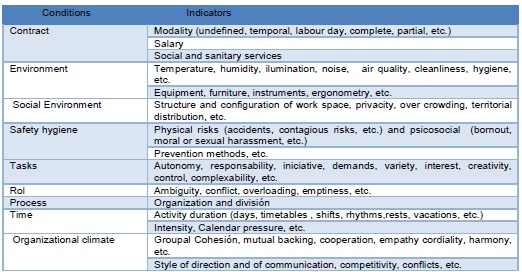
Sourse: Peiró & Prieto (1996) citado por Blanch (2003, p. 44)
The previous inventory, however, are part of a macro-social framework that defines the circumstances that affect the development of labor relations in a society, which is why working conditions also include aspects related to the labor market, the forms of collective or individual negotiation, the action of unions, public employment policies, labor legislation, the dynamics between employment, underemployment and unemployment, among others, whose consideration contextualizes to a large extent many of the conditions that at the organizational level experience the employees and whose quality of work life is differential according to variables such as the position held, the type of contract, the degree of qualification, the remuneration, among other elements.
According to the list presented in the table above, it can be established that working conditions are an essential element that affects the quality of working life (CVL) in aspects such as: health, psychological well-being, motivation, satisfaction of the tasks that are carried out and in aspects related to the physical as, for example, the wear. In the same way, such conditions are determinant in the performance that a person can have in the development of their activities, in the turnover rates of personnel and in other aspects such as the efficiency and efficiency of the organization (Blanch, 2003).
In this way, the quality of life can be understood as:
"A state of general satisfaction, derived from the realization of the potential of the person. It has subjective aspects and objective aspects. It is a subjective feeling of physical, psychological and social well-being. It includes, as subjective aspects, intimacy, emotional expression, perceived safety, personal productivity and perceived health. Objective aspects include material well-being, harmonious relationships with the physical and social environment and with the community, and objectively perceived health "(Ardila, 2003, p.36).
In the previous definition highlights aspects such as physical, psychological and social well-being, which in turn are highlighted by Blanch, when he defines the CVL as "the degree of satisfaction and physical, psychological and social well-being experienced by the people in his position and in his work environment "(2003, p.36)
For its part, Casas, Repullo, Lorenzo, & Cañas, (2002) establish a relationship between working conditions and CVL, understanding the latter in relation to aspects that optimize the employee's satisfactory experience in their work environment. Thus, CLV covers:
"All those conditions related to work, such as hours, compensation, the work environment, benefits and services obtained, professional career possibilities, human relationships, etc., which may be relevant for satisfaction, motivation and work performance. The CVL can be defined, then, as a dynamic and continuous process in which the work activity is organized objectively and subjectively, both in its operational and relational aspects, in order to contribute to the more complete development of the human being "(Casas et al. ., 2002 P. 144).
According to the above, the CVL seeks to have a coherent relationship between the human experience and the objectives established in the organization, thereby seeking compliance with the objectives and strategies established in the institution. Likewise, the physical, environmental and psychological aspects of the workplace play an important role in the CVL, since with the CVL the collaborators are seeking their vindication for the comfort and pleasure in the work performed and, on the other hand side, the interest of the organization in achieving a high index in productivity.
Bearing in mind that the CVL seeks to have a high degree of satisfaction of the needs of workers through the execution of a task, it must be understood that, in order to achieve said satisfaction, it is necessary to respond to factors such as:
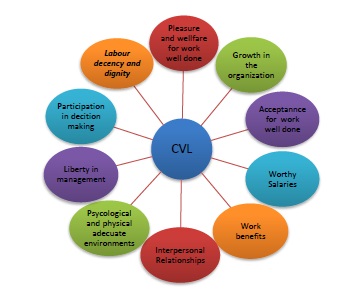
Figura N° 3: Flexible organization model
Source: Own Elaboration as from Chiavenato (2009).
Labor dignity and decency: an overview of working conditions in Colombia and Mexico
Work dignity and decency are two important elements that need to be analyzed as a component for the CVL. Dignity has been a term that has been present for a long time in a variety of international documents related to rights, and that has gained importance in a social state of law such as Colombia and Mexico, which is reflected in the Constitution, of these two nations when it has been established that work is a principle, a duty and a right.
Now, both in Colombia and in Mexico, work is a fundamental principle and part of human dignity, as the foundation for a social state of law. Therefore, it is important to understand that the concept of human dignity understood from the jurisprudential is understood from two dimensions on the one hand as protection and on the other from a normative functionality. In view of the above, it is necessary, in Colombia, for example:
Having as its point of view the object of protection of the normative statement "human dignity", the Chamber has identified throughout the jurisprudence of the Court, three clear and differentiable guidelines: (i) Human dignity understood as autonomy or as possibility to design a vital plan and to determine according to its characteristics (live as you want). (ii) Human dignity understood as certain concrete material conditions of existence (living well). And (iii) human dignity understood as intangibility of non-patrimonial goods, physical integrity and moral integrity (living without humiliation). On the other hand, having the functionality of the normative statement "human dignity" as its point of view, the Chamber has identified three guidelines: (i) human dignity understood as a founding principle of the legal system and therefore of the State, and in this sense dignity as value. (ii) Human dignity understood as a constitutional principle. And (iii) human dignity understood as an autonomous fundamental right (Constitutional Court of Colombia, 2002, p.1).
Therefore, the work must be constituted as an element that guarantees the dignity and the fundamental right that every citizen has in the national territory. Equally, dignity must guarantee workers honorable treatment for the mere fact of their human nature. Faced with the above, "the dignity of the human person does not allow it to be reduced to the condition of thing or object, lacking autonomy, what happens when by particular acts the freedom or the body of a human being is available" (Colombian Constitutional Court, 1994, p.12).
With regard to work decency, this is a relatively new concept that was used for the first time in 1999 at the International Labor Conference held in Geneva and was the International Labor Organization (ILO) who used this term in the conference entitled Report of the Director General: Decent work that sought to enact decent work as a strategy and therefore promulgated that "Currently, the primary purpose of the ILO is to promote opportunities for men and women to get a decent and productive job in conditions of freedom, equity, security and human dignity "(International Labor Organization (ILO), 1999, p.1). It is important to point out that the ILO has founded that, in order to comply with the above, it is necessary to enact the development of four strategic objectives:
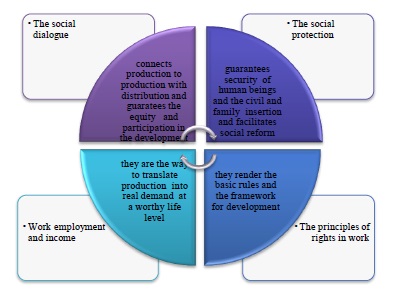
Figura N°4: Components of decent work
Source: Own Elaboration as from ILO (1999)
According to the previous illustration, it can be identified that work is a principle and an unavoidable right for any citizen, which means that any person can access a job in a dignified and decent manner according to the policies and rules defined by each nation.
The possibility of accessing decent employment is an action that translates into a mechanism that guarantees the development of nations and the reduction of poverty in the nations. Therefore, both Mexico and Colombia have spared no effort to ensure that its citizens have jobs characterized by dignity and decency.
Social dialogue is another of the components that the ILO has proposed through its strategic objectives and with that, what has been sought has been equity, equality and peace among all social actors where "we must persevere along this path, seeking not only to remove all obstacles that may exist for the free establishment and functioning of employers 'and workers' organizations, but also develop the institutional framework required by social dialogue "(International Labor Organization (ILO), 2006, p.22) ).
Social security and protection are a need that must be guaranteed in any nation, therefore, this has become another of the ILO's strategic objectives and, therefore, it is sought that upon cessation of work, all people have the possibility of continuing with a decent life as a reward for so many years of work.
It could be understood then, the concept of decent work as a synonym of job opportunities between men and women based on conditions of labor quality, social integration and workers' rights.
As explained above, decent work is a concept that must be embedded in what is the quality of life at work, that is, not only is the well-being of the employee within the organization at stake, but also all the actions that this one develops to generate pleasure, tranquility and benefits to the employees in such a way that it can achieve the fulfillment of the objectives that the organization has proposed.
In the interest of promoting equal labor law, framed in decent and decent work by the ILO, it has proposed a hemispheric agenda with the pretension that each nation with its application mitigates poverty and inequality. However, with this agenda it has been sought that both men and women can access jobs characterized by decency under the framework of some guidelines of freedom, justice, security and human dignity, since the ILO has proposed in its objectives the "Promotion of fundamental rights at work; the job; social protection and social dialogue "(International Labor Organization (ILO), 1999, p.12).
Being the work, an essential principle and right, both Mexico and Colombia have established it in their political constitution, this being a fundamental element for the ILO to have thought about the search for solutions to problems addressed through its strategic objectives that would resolve some social difficulties and violence that in recent years have been present in these two nations.
Finally, it is important to emphasize that the concept of decent work is widespread and that its application will depend on the policies of each nation, the economic context and the established regulations.
SMEs in the Mexican and Colombian context
The decade of the nineties, has been characterized by economic, social and technological development in countries such as Mexico, Brazil, Argentina and Colombia among others, development that has touched SMEs in relation to the generation of regulatory regulation, focused on accompaniment, advice and support in its development. The objective of this regulation is based on the "creation of employment, the development of human capital, regional integration and development, the increase of productivity and the promotion of competition in the markets" (Ferro, 2005, p.10).
Each country defines SMEs using essentially quantitative guidelines that, while having certain similar characteristics, also have significant differences. In most cases, the variables considered are number of personnel, sales figure and levels of investment in assets or participation in the market (Saavedra & Hernández, 2008).
It is important to have stratification criteria of the companies that are homogeneous and that allow establishing an officially accepted taxonomy. From the governmental perspective, this taxonomy helps to identify how important a certain stratum of enterprise is for the national economy; its contribution to the generation of employment and, therefore, the possibility of access to support programs designed and structured for a Specific treatment. In the case of Mexico, such stratification is legally mandatory by provision of the Law for the Development of Competitiveness in Micro, Small and Medium Enterprises (December 30, 2002), which in its Article 3 establishes a basic criterion of stratification (Table 2).
Table N°2: MiPyME stratification of the Law for the development of competiveness in the micro, small and médium enterprise

Source: (México: Chamber of Deputies, 2015)
That same article establishes the need for such a base to be supplemented by agreement between the Ministry of Finance and Public Credit and the Ministry of Economy, published in the Official Gazette of the Federation. The current taxonomist criterion dates from June 25th , 2009 and, in addition to the number of workers (used in the base criterion), considers -priority- the annual sales of the company. Table 3 shows this criterion that should be considered as definitive in Mexico.
Table N°3: Stratification of the MiPyME
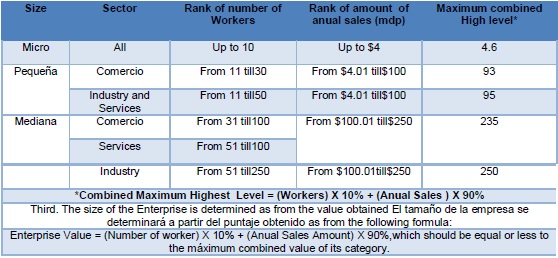
Source: (México: Chamber of Deputies, 2015)
In short, MSMEs represented 99.8% of the total number of companies in the country and their contribution to GDP amounted to 52% of the total, with a contribution to employment totaling 72.1%, which shows the crucial importance of these companies.
In the Colombian context, SMEs are defined by the Framework Law 905 of 2004, as any economic exploitation unit, carried out by a natural or legal person, in business, agricultural, industrial, commercial or service activities, rural or urban. Legislation that makes a characterization of what constitutes small and medium enterprises, giving their specifications for three models. A first, nominated median that has a staff plant between fifty-one (51) and two hundred (200) workers, with total assets between 5,001 to 15,000 legal monthly minimum wages in force. The second considered small, with a staff plant between eleven (11) and fifty (50) workers, with total assets worth between five hundred one (501) and less than five thousand (5,000) legal minimum monthly wages in force. And, the last one called Micro Company, with a staff plant not exceeding ten (10) workers, with total assets, excluding housing, for less than five hundred (500) minimum legal monthly salaries in force. In the following table, the business classification in Colombia is presented according to the definition stated above:
Table N°4: Classification according to the kind of Colombian Enterprise

Source: (Montoya, Montoya, & Castellanos, 2010, p. 5)
One aspect to highlight is the support that since the eighties in Colombia has been given to the business sector, especially the small, medium and microenterprise with the formulation and application of support policies for their strengthening and development.
For the Colombian state, support for the business sector is strengthened by the formulation of the National Plan for the Development of Microenterprise in 1982, which was promoted by the Government of the time, private institutions and international organizations, mainly the Bank. Inter-American Development this Plan was the object of several updates and versions for more than 15 years, becoming the manager of a system of support and institutional impulse for the microenterprise, in the context of Latin America.
An important element is that SMEs in Colombia currently represent 96% of the companies in the country and generate approximately 70% of the employment of Colombians (Montoya, Montoya, & Castellanos, 2010) and represent the 37 % of national GDP.
Method
The realization of this work has been proposed from 2 phases, taking into account that it is a project that is still in the execution stage.
• Phase 1: Literature review, which sought to conceptualize and contrast the different positions of the authors in relation to the work related to decent work.
• Phase 2: propose some more relevant indicators that will help to respond to the objectives set out in the work and that would allow to identify the adherence levels of the strategic objectives proposed by the ILO.
It is important to highlight that the development of a proposal of indicators is subject to verification through its subsequent application in specific cases. Companies or organizations can make use of them to corroborate if they comply with the laudable purpose proposed by the ILO: decent work.
The proposed variables are not operationalized since it is a preliminary and descriptive analysis; subject to modifications that depend on aspects specific to each of the countries and realities.
Preliminary results
As part of the research result, some indicators have been proposed, which have been divided into four thematic axes according to the strategies proposed by the ILO for decent and decent work:
1. Fundamental principles and rights at work.
2. Employment opportunities for men and women.
3. Security in employment.
4. Dialogue or social participation.
Within the four axes presented above, some indicators have been exposed that may give an account of the process that is being undertaken in the face of the generation of decent work as a mechanism for the development of sustainability and the competitiveness of SMEs in general. On the other hand, these indicators can be applied to any type of organization by its generality. It is important to clarify that such indicators only constitute proposals that are in the process of development and improvement, taking into account that this document is the preliminary result of the macro project Adoption of sustainability criteria in value chains in Latin America, specifically the issue related to the quality of working life.
With the proposal presented below, we seek to have a tool that allows measuring or quantifying the achievement of adherence that organizations have had to the ILO proposal. It is important to clarify that this proposal does not seek to evaluate to judge, but to serve as an input for both organizations and whoever decides to apply this instrument, can identify the aspects that can improve to contribute in this way, to the development of the country and the same organization. Finally, it should be clarified that, although the enunciative list presented below is not exhaustive, if it represents in a general way, some factors that will allow SMEs to identify how they are contributing to the development of the country and the generation of new opportunities .
Table N°5: Classification according to the kind of Colombian Enterprise
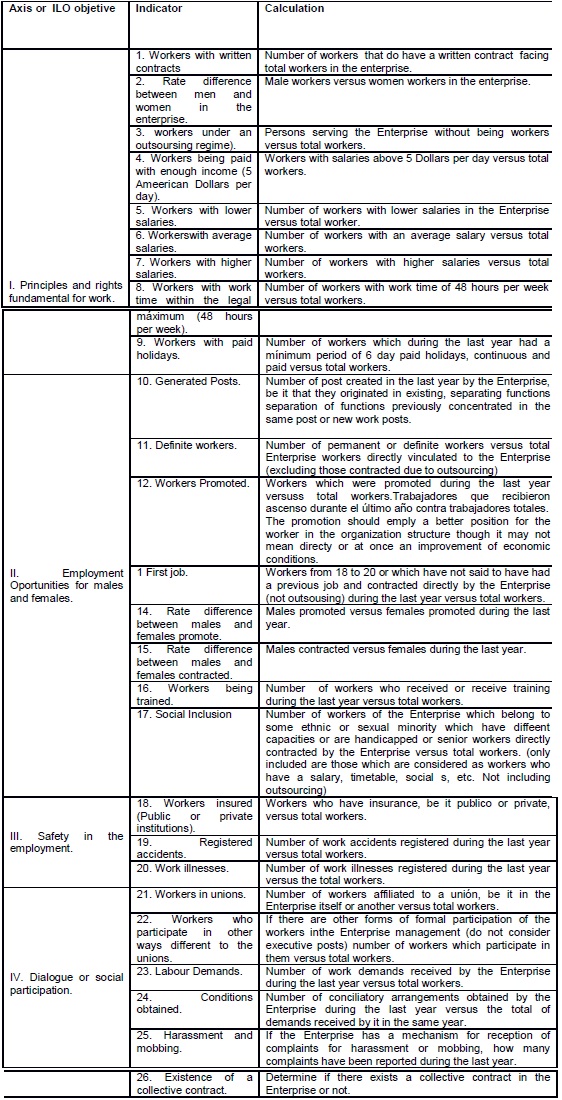
Source: Own Elaboration
CONCLUSIONS
Both in Mexico and Colombia, actions have been proposed aimed at generating decent work for the development of the nation and the quality of life of all, based on equal rights.
The quality of working life is a fundamental element for SMEs to have committed staff that helps them achieve institutional objectives and the generation of decent work characterized by equality and the generation of equal opportunities.
It is necessary that each nation develop actions aimed at evaluating their labor policies in order to adapt them in such a way that the strategies proposed by the ILO in relation to decent work are fulfilled.
The proposal of indicators is not an exhaustive list, much less the solution to the problems faced with labor difficulties or the absence of decent work as proposed by the ILO in any type of organization.
The SMEs of Mexico and Colombia are organizations to which the list of proposed indicators can be applied in order to identify the way in which these organizations could contribute to the development of each nation and to the generation of decent employment in such a way that it can guarantee the generation of opportunities for all citizens and for the development of this particular type of organization.
BIBLIOGRAPHCIAL ABSTRACT
Please refer to articles Spanish Biographical abstract.
REFERENCES
Please refer to articles in Spanish Bibliography.